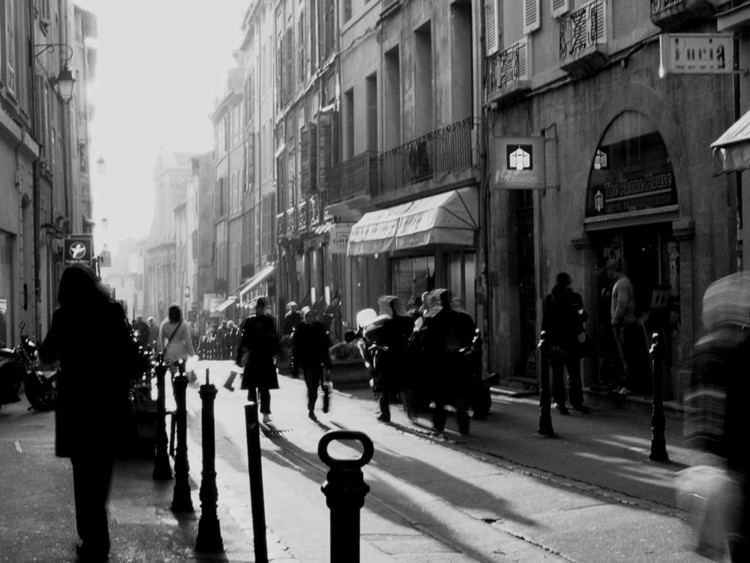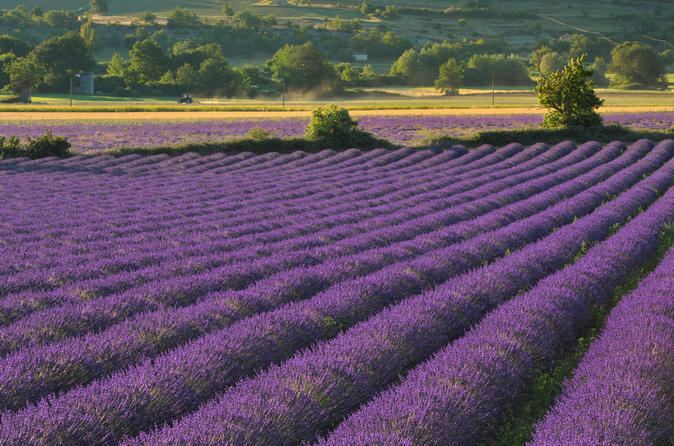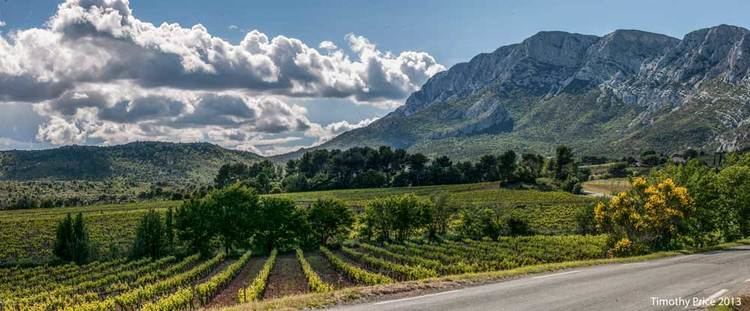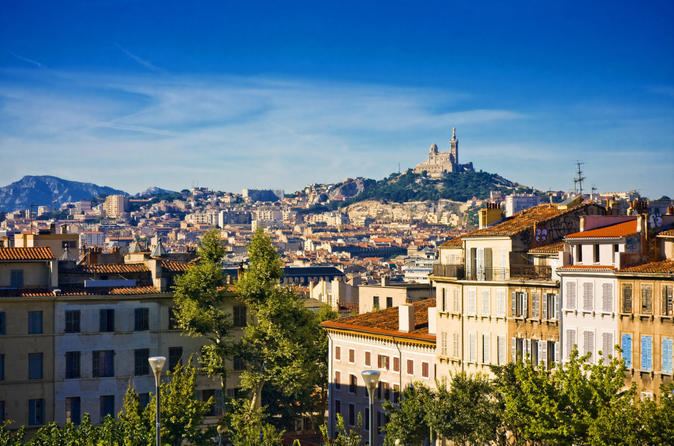Country France Area 142,743 | ||
 | ||
Points of interest Cours Mirabeau, Aix Cathedral, Eglise Saint-Jean-de-Malte, Museum dHistoire Naturelle Aix-en-Provence, Aix-en-Provence Festival Colleges and Universities Universite Paul Cezanne Aix-Marseille III, IAE Aix-en-Provence, Ecole Superieure dArt dAix-en-Provence | ||
Mayor Maryse Joissains-Masini (UMP) | ||
Map of Aix-en-Provence
Aix-en-Provence ([ɛksɑ̃pʁɔvɑ̃s]; Provençal Occitan: Ais de Provença in classical norm, or Ais de Prouvènço in Mistralian norm, [ˈajz de pʀuˈvɛⁿsɔ], Latin: Aquae Sextiae), or simply Aix ([ɛks]; medieval Occitan Aics), is a city-commune in the south of France, about 30 km (19 mi) north of Marseille. A former capital of Provence, it is in the region of Provence-Alpes-Côte d'Azur, in the department of Bouches-du-Rhône, of which it is a subprefecture. The population of Aix numbers approximately 143,000. Its inhabitants are called Aixois or, less commonly, Aquisextains.
Contents
- Map of Aix en Provence
- Wine food and discovery in aixenprovence
- History
- Geography and climate
- Sights
- Education
- Music
- Festival dAix en Provence
- Musique dans la Rue
- Dance
- European Capital of Culture
- Museums and Libraries
- Montagne Sainte Victoire
- Sport
- Economy
- Transport
- Miscellaneous
- International relations
- Births
- Famous residents
- References

Wine food and discovery in aixenprovence
History

Aix (Aquae Sextiae) was founded in 123 BC by the Roman consul Sextius Calvinus, who gave his name to its springs, following the destruction of the nearby Gallic oppidum at Entremont. In 102 BC its neighbourhood was the scene of the Battle of Aquae Sextiae, where the Romans under Gaius Marius defeated the Cimbri and Teutones, with mass suicides among the captured women, which passed into Roman legends of Germanic heroism.

In the 4th century AD it became the metropolis of Narbonensis Secunda. It was occupied by the Visigoths in 477. In the succeeding century, the town was repeatedly plundered by the Franks and Lombards, and was occupied by the Saracens in 731 and by Charles Martel in 737. Aix, which during the Middle Ages was the capital of Provence, did not reach its zenith until after the 12th century, when, under the houses of Barcelona/Aragon and Anjou, it became an artistic centre and seat of learning.

Aix passed to the crown of France with the rest of Provence in 1487, and in 1501 Louis XII established there the parliament of Provence, which existed until 1789. In the 17th and 18th centuries, the town was the seat of the Intendance of Provence.

Current archeological excavations in the Ville des Tours, a medieval suburb of Aix, have unearthed the remains of a Roman amphitheatre. A deposit of fossil bones from the Upper Continental Miocene gave rise to a Christian dragon legend
Geography and climate

Aix-en-Provence is situated in a plain overlooking the Arc, about a mile from the right bank of the river. The city slopes gently from north to south and the Montagne Sainte-Victoire can easily be seen to the east. Aix's position in the south of France gives it a warm climate, though more extreme than Marseille due to the inland location. It has an average January temperature of 5 °C (41 °F) and a July average of 23 °C (73 °F). It has an average of 300 days of sunshine and only 91 days of rain. While it is partially protected from the Mistral, Aix still occasionally experiences the cooler and gusty conditions it brings.
Unlike most of France which has an oceanic climate, Aix-en-Provence has a Mediterranean climate.
Sights
The Cours Mirabeau is a wide thoroughfare, planted with double rows of plane trees, bordered by fine houses and decorated by fountains. It follows the line of the old city wall, and divides the town into two sections. The new town extends to the south and west; the old town, with its narrow, irregular streets and its old mansions dating from the 16th, 17th and 18th centuries, lies to the north. Situated on this avenue, which is lined on one side with banks and on the other with cafés, is the Deux Garçons, the most famous brasserie in Aix. Built in 1792, it was frequented by the likes of Paul Cézanne, Émile Zola and Ernest Hemingway.
The Cathedral of the Holy Saviour (Aix Cathedral) is situated to the north in the medieval part of Aix. Built on the site of a former Roman forum and an adjacent basilica, it contains a mixture of all styles from the 5th to the 17th century, including a richly decorated portal in the Gothic style with doors elaborately carved in walnut. The interior contains 16th-century tapestries, a 15th-century triptych, depicting King René and his wife on the side panels, as well as a Merovingian baptistery, its Renaissance dome supported by original Roman columns. The archbishop's palace (Palais de l'Archêveché) and a Romanesque cloister adjoin the cathedral on its south side. The Archbishopric of Aix is now shared with Arles.
Among its other public institutions, Aix also has the second most important Appeal Court (Palais de Justice) outside of Paris, located near the site of the former Palace of the Counts (Palais des Comtes) of Provence.
The Hôtel de Ville, a building in the classical style of the middle of the 17th century, looks onto a picturesque square (place de l'Hôtel de Ville). It contains some fine woodwork and tapestries. At its side rises a handsome clock-tower erected in 1510. Also on the Place de l'Hôtel de Ville is the former Corn Exchange (1759–1761) (Halle de Grains). This ornately decorated 18th-century building was designed by the Vallon brothers. Nearby are the remarkable thermal springs, containing lime and carbonic acid, that first drew the Romans to Aix and gave it the name Aquae Sextiae. A spa was built in 1705 near the remains of the ancient Roman baths of Sextius.
South of the Cours Mirabeau is the Quartier Mazarin. This residential district was constructed for the gentry of Aix by Archbishop Michele Mazzarino brother of Cardinal Jules Mazarin in the last half of the 17th century and contains several notable hôtels particuliers. The 13th-century church of Saint-Jean-de-Malte contains valuable pictures and a recently restored organ. Next to it is the Musée Granet, devoted to European painting and sculpture.
Aix is often referred to as the city of a thousand fountains. Among the most notable are the 17th-century Fontaine des Quatre Dauphins (Fountain of the Four Dolphins) in the Quartier Mazarin, designed by Jean-Claude Rambot, and three of the fountains down the central Cours Mirabeau: At the top, a 19th-century fountain depicts the "good king" René holding the Muscat grapes that he introduced to Provence in the 15th century; halfway down is a natural hot water fountain (34 °C), covered in moss, dating back to the Romans; and at the bottom at la Rotonde, the hub of modern Aix, stands a monumental fountain from 1860 beneath three giant statues representing art, justice and agriculture. In the older part of Aix, there are also fountains of note in the Place d'Albertas and the Place des Trois-Ormeaux.
Education
Aix has long been a university town: Louis II of Anjou granted a royal charter for a university in 1409. Today Aix remains an important educational centre, with many teaching and research institutes:
Aix also has several training collèges, lycées, and a college of art and design. It has also become a centre for many international study programmes. Several lycées offer CPGE
Music
Aix holds two significant musical events each year. These are:
Festival d'Aix-en-Provence
An important opera festival, the Festival international d'Art Lyrique, founded in 1948, now ranks with those in Bayreuth, Salzburg and Glyndebourne. The current director is Bernard Foccroulle, director of la Monnaie in Brussels. The festival takes place in late June and July each year. The main venues in Aix itself are the outdoor Théâtre de l'Archévêché in the former garden of the archbishop's palace, the recently restored 18th-century Théâtre du Jeu de Paume, and the newly built Grand Théâtre de Provence; operas are also staged in the outdoor Théâtre du Grand Saint-Jean outside Aix. Linked to the festival is the Académie européenne de musique, a summer school for young musicians with master classes by celebrated artists. Over the four-year period from 2006 until 2009, Sir Simon Rattle's version of Wagner's Ring Cycle with the Berlin Philharmonic was performed at the Aix festival.
Musique dans la Rue
This takes place each year in June to coincide with the national 'Fête de la Musique.' There is a week of classical, jazz and popular concerts held in different street venues and courtyards in the city. Some of these events are held in the Conservatoire Darius Milhaud, named in honour of the French composer, a native of Aix.
Dance
The dance company Ballet Preljocaj of the French dancer and choreographer Angelin Preljocaj has been located in Aix since 1996. In 2007 it took up residence in the Pavillon Noir, a centre for dance performance, designed in 1999 by the architect Rudy Ricciotti. The centre is one of nineteen of its kind in France, designated Centre chorégraphique national.
European Capital of Culture
Aix-en-Provence was part of Marseille-Provence 2013, the year-long cultural festival when the region served as the European Capital of Culture. Aix hosted several major cultural events including one half of the Grand Atelier du Midi gala exhibition and an episode of the Révélations pyrotechnical performance. The city also unveiled major new cultural infrastructure to coincide with Marseille-Provence 2013, including the Darius Milhaud Conservatory designed by Kengo Kuma.
Museums and Libraries
Aix has several museums and galleries:
Prior to 1989 Aix had several libraries, for example in the Parc Jourdan and the Town Hall. In 1989, many of these were moved to the Méjanes, an old match factory.
In 1993, the "Cité du Livre" was opened around the library. This has media spaces for dance, cinema and music, and a training facility for librarians. Adjacent to the Cité du Livre are the Grand Théâtre de Provence and the Pavillon Noir (see above).
Montagne Sainte-Victoire
To the east of Aix rises the Montagne Sainte-Victoire (1011 m), one of the landmarks of the Pays d'Aix. It is accessible from the centre of Aix by road or on foot, taking the wooded footpath of Escrachou Pevou to the plateau of Bibemus. It dramatically overshadows the small dam built by Émile Zola's father and was a favourite subject and haunt of Paul Cézanne throughout his lifetime. In the village of le Tholonet on the precipitous southern side of Mont Sainte-Victoire, there is a windmill that he used and beyond that a mountain hut, the refuge Cézanne, where he liked to paint.
To the north, the mountain slopes gently down through woodland to the village of Vauvenargues. The Château of Vauvenargues overlooking the village was formerly occupied by the Counts of Provence (including René of Anjou) and the Archbishops of Aix before it became the family home of the marquis de Vauvenargues. It was acquired by the Spanish artist Pablo Picasso in 1958, who was resident there from 1959 until 1962, when he moved to Mougins. He and his wife Jacqueline are buried in its grounds, which are not usually open to the public. From 2009 onwards, the château, which now belongs to Jacqueline's daughter Catherine Hutin, has been open to the public from June to September.
Mont Sainte-Victoire has a complex network of paths, leading to the priory and Croix de Provence at the summit, to the large man-made reservoir of Bimont and to the Roman viaduct above le Tholonet.
Sport
Economy
Industries formerly included flour-milling, the manufacture of confectionery, iron-ware, hats, matches and the extraction of olive oil.
Current economic activities include:
The airline Twin Jet has its head office in Aix-en-Provence.
Transport
A set of ancient roads radiate out from Aix to the surrounding countryside, the Pays d'Aix. There are also a large number of modern autoroutes connecting Aix to nearby towns. There are autoroutes northwards to Avignon and to the Luberon; southwards to Marseille; and eastwards to Aubagne and the Mediterranean coast of Provence; and to Nice and other towns on the French Riviera. Aix and Marseille are equidistant from the Marseille Provence Airport (MRS) at Marignane on the Etang de Berre which features domestic and international scheduled passenger service. There is another airport at Les Milles, which is mostly used by general aviation. There is a frequent bus shuttle service from the main bus station in Aix which also serves the nearby TGV station at l'Arbois, in the middle of the countryside about 10 miles (16 km) from Aix.
At Aix, the line from Paris branches to Marseille and Nice; it takes about 3 hours to get from Paris to Aix by TGV. Aix also has a railway station near the centre, Gare d'Aix-en-Provence, with connections to Marseille, Pertuis and Briançon in the French Alps. A frequent and rapid shuttle bus service for commuters operates between the bus station in Aix and Marseille. There are many other long distance and local buses from the bus station.
In the town itself, there is an inexpensive municipal bus service, including a dial-a-bus service ("proxibus"), a park-and-ride service and tiny electrified buses for those with mobility problems. Those are six seater vehicles that circulate at a speed of 10 mph (16.09 km/h). The central old town of Aix is for the most part pedestrianised. There are large underground and overground parking structures placed at regular intervals on the "boulevard exterieur", the predominantly one-way ring road that encircles the old town. Access to the old town is by a series of often narrow one-way streets that can be confusing to navigate for the uninitiated.
As in many other French cities, a short-term bicycle hire scheme nicknamed V'Hello, free for trips of less than half an hour, has recently been put in place by the town council: and has been popular with tourists. As well as overland routes, two "rivers" flow through Aix, the Arc and the Torse, but neither of which can remotely be described as navigable.
Miscellaneous
The local Aix dialect, rarely used and spoken by a rapidly decreasing number of people, is part of the provencal dialect of the Occitan language. The provencal for "Aix-en-Provence" is "Ais de Prouvènço" [ˈaj de pʀuˈvɛ̃sɔ]. Most of the older streets in Aix have names in both Provençal and French.
Aix hosted the ninth International Congress of Modern Architecture in 1953.
Aix is the home town of the rugby union team Provence Rugby. It played host to the All Blacks during the early stages of the 2007 Rugby World Cup.
Ysabel, the tenth novel of the best-selling Canadian author Guy Gavriel Kay, was set and written in Aix.
Italian electroacoustic artist Giuseppe Ielasi's album Aix was produced in Aix-en-Provence, hence the title.
This is also the site of an alleged sighting and landing of a UFO in 1981 that is taken seriously by GEIPAN, the department within the French Space Agency responsible for investigating aerospace phenomena.
International relations
Aix-en-Provence is officially twinned with the following seven cities (in alphabetical order):
In addition, Aix has international cooperations, partnerships and exchanges with the following cities from all over the world:
Births
Aix-en-Provence was the birthplace of:
